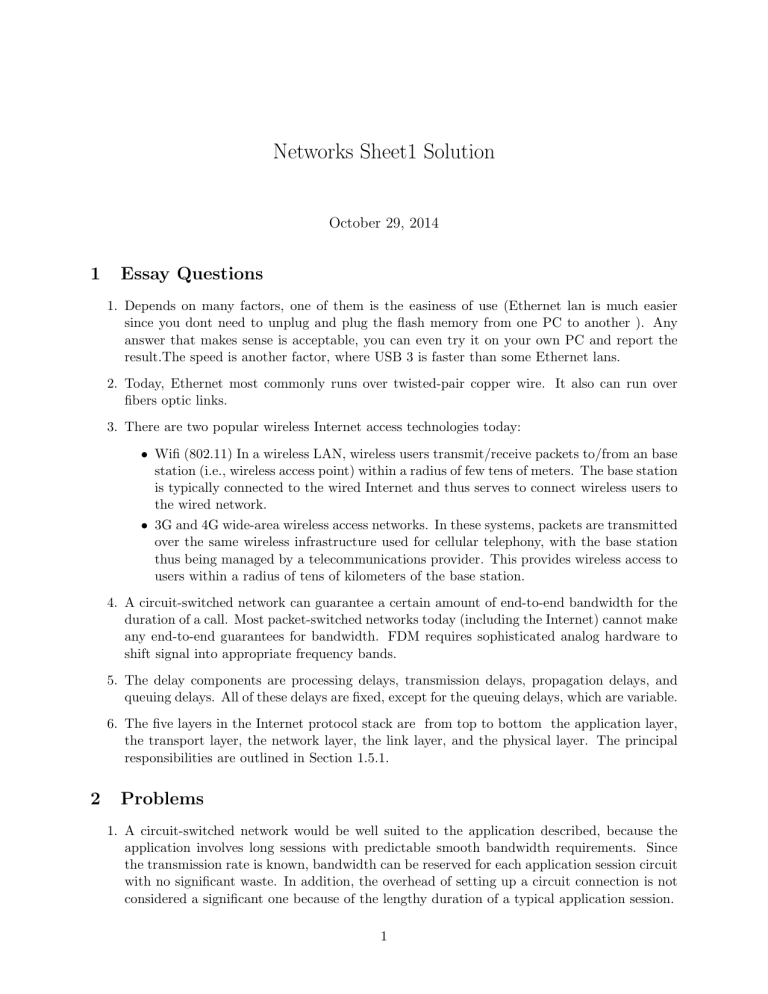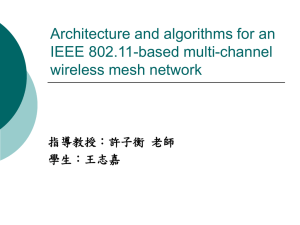
Networks Sheet1 Solution October 29, 2014 1 Essay Questions 1. Depends on many factors, one of them is the easiness of use (Ethernet lan is much easier since you dont need to unplug and plug the flash memory from one PC to another ). Any answer that makes sense is acceptable, you can even try it on your own PC and report the result.The speed is another factor, where USB 3 is faster than some Ethernet lans. 2. Today, Ethernet most commonly runs over twisted-pair copper wire. It also can run over fibers optic links. 3. There are two popular wireless Internet access technologies today: • Wifi (802.11) In a wireless LAN, wireless users transmit/receive packets to/from an base station (i.e., wireless access point) within a radius of few tens of meters. The base station is typically connected to the wired Internet and thus serves to connect wireless users to the wired network. • 3G and 4G wide-area wireless access networks. In these systems, packets are transmitted over the same wireless infrastructure used for cellular telephony, with the base station thus being managed by a telecommunications provider. This provides wireless access to users within a radius of tens of kilometers of the base station. 4. A circuit-switched network can guarantee a certain amount of end-to-end bandwidth for the duration of a call. Most packet-switched networks today (including the Internet) cannot make any end-to-end guarantees for bandwidth. FDM requires sophisticated analog hardware to shift signal into appropriate frequency bands. 5. The delay components are processing delays, transmission delays, propagation delays, and queuing delays. All of these delays are fixed, except for the queuing delays, which are variable. 6. The five layers in the Internet protocol stack are from top to bottom the application layer, the transport layer, the network layer, the link layer, and the physical layer. The principal responsibilities are outlined in Section 1.5.1. 2 Problems 1. A circuit-switched network would be well suited to the application described, because the application involves long sessions with predictable smooth bandwidth requirements. Since the transmission rate is known, bandwidth can be reserved for each application session circuit with no significant waste. In addition, the overhead of setting up a circuit connection is not considered a significant one because of the lengthy duration of a typical application session. 1 2. 10msec; d/s; no; no 3. As TDM with 6 slots/sec, then the host can send 781.5 Kbps each 6 seconds 781.5*1000 bits − > 6 seconds 160*1000 bits − > x seconds Then x = 1.228 sec Total time = 1.228 + 0.25 = 1.478 sec 4. Recall geostationary satellite is 36,000 kilometers away from earth surface. a) 150 msec b) 1,500,000 bits c) To enforce the continuous transmission of the link, we need to equate the transmission delay with the waiting time for new photo (one minute) x Therefor, R = 60 seconds So, x = 60 ∗ R = 60 ∗ 107 = 600,000,000 bits 5. a) Throughput is limited to the least link. So, throughput = 500 kbps b) 64 seconds c) 100kbps; 320 seconds 6. a) 2 users can be supported because each user requires half of the link bandwidth. b) Since each user requires 1Mbps when transmitting, if two or fewer users transmit simultaneously, a maximum of 2Mbps will be required. Since the available bandwidth of the shared link is 2Mbps, there will be no queuing delay before the link. Whereas, if three users transmit simultaneously, the bandwidth required will be 3Mbps which is more than the available bandwidth of the shared link. In this case, there will be queuing delay before the link. c) Probability that a given user is transmitting = 0.2 3 p3 (1 − p)3−3 = 3 (0.2)3 = 0.008. Since the queue grows when all the users are transmitting, the fraction of time during which the queue grows (which is equal to the probability that all three users are transmitting simultaneously) is 0.008. d) Probability that all three users are transmitting simultaneously = 2


